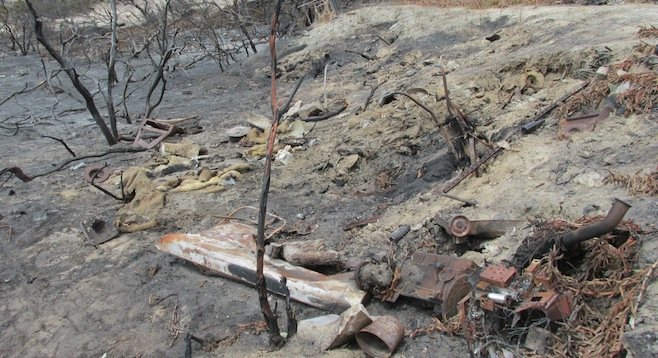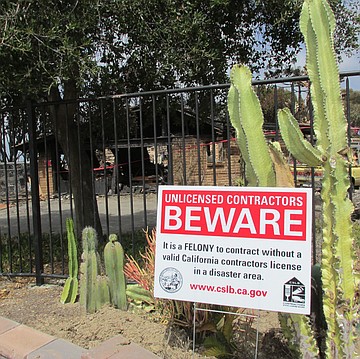 Facebook
Facebook
 X
X
 Instagram
Instagram
 TikTok
TikTok
 Youtube
Youtube

A May 19 visit to the 1700 block of Poinsettia Lane, site of Carlsbad’s “Poinsettia Fire,” revealed a much different scene than just one week ago: apparently, illegal dumpers have been throwing their trash in the canyon at the dead end street, probably for decades.
Without the heavy brush and scrub trees, the harsh landscape revealed illegal dumping all over the valley. Deposited over the banks, once hidden from view by the shrubbery, are car parts, engine blocks, chairs, TV sets, carpet, bicycles, shopping carts, wheel rims, and construction debris.
Out about 100 yards, there was the sign of an encampment — probably built by farm workers from the few remaining crop fields in the area. A metal pole structure, about 10 x 20 feet, was all that remained, along with remains of chairs and other metal debris.

With the eye-stinging ash still being whipped up from the coastal breeze across the valley between Poinsettia Lane and Ambrosia Lane, viewers stood in amazement. Beyond the initial shock the destruction, one quickly realized the saving grace that firefighters were able to keep the damage to the loss of only one home along the populated three streets of Circle Court, Poinsettia Lane, and Skimmer Court.
Richard Halsey from the California Chaparral Institute was onsite to take photos and study the area’s destruction. The area burned so hot, the soil became “purified,” meaning all bacteria were burned up.
The valley, part of the 60 acres burned, contained coyote bush, lemonade berry shrub, coastal sage, and large manzanita trees. One remaining manzanita tree was about ten feet tall. Halsey said that the tree, based on the size of the trunk, had to be 80 to 90 years old, which would indicate the last time a fire had burned through the area.


A May 19 visit to the 1700 block of Poinsettia Lane, site of Carlsbad’s “Poinsettia Fire,” revealed a much different scene than just one week ago: apparently, illegal dumpers have been throwing their trash in the canyon at the dead end street, probably for decades.
Without the heavy brush and scrub trees, the harsh landscape revealed illegal dumping all over the valley. Deposited over the banks, once hidden from view by the shrubbery, are car parts, engine blocks, chairs, TV sets, carpet, bicycles, shopping carts, wheel rims, and construction debris.
Out about 100 yards, there was the sign of an encampment — probably built by farm workers from the few remaining crop fields in the area. A metal pole structure, about 10 x 20 feet, was all that remained, along with remains of chairs and other metal debris.

With the eye-stinging ash still being whipped up from the coastal breeze across the valley between Poinsettia Lane and Ambrosia Lane, viewers stood in amazement. Beyond the initial shock the destruction, one quickly realized the saving grace that firefighters were able to keep the damage to the loss of only one home along the populated three streets of Circle Court, Poinsettia Lane, and Skimmer Court.
Richard Halsey from the California Chaparral Institute was onsite to take photos and study the area’s destruction. The area burned so hot, the soil became “purified,” meaning all bacteria were burned up.
The valley, part of the 60 acres burned, contained coyote bush, lemonade berry shrub, coastal sage, and large manzanita trees. One remaining manzanita tree was about ten feet tall. Halsey said that the tree, based on the size of the trunk, had to be 80 to 90 years old, which would indicate the last time a fire had burned through the area.